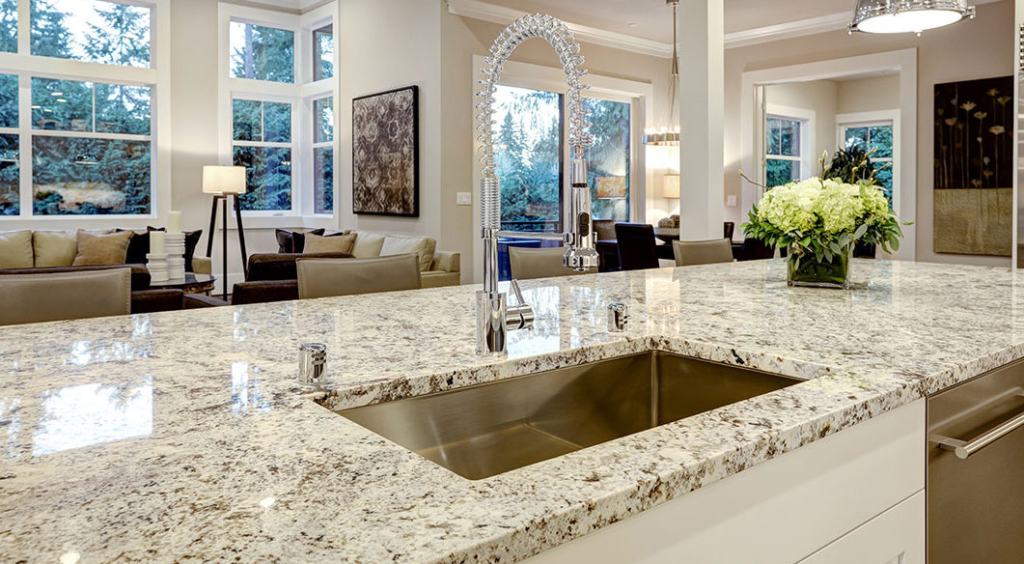Key Takeaways
- Granite’s unique formation process makes it a durable choice for various applications.
- This natural stone offers aesthetic versatility and strength.
- Granite production impacts local economies and environmental sustainability.
- Care and maintenance are crucial for preserving granite’s natural beauty.
The Origins of Granite
Granite is a magnificent natural stone formed from the slow crystallization of magma beneath the Earth’s surface. This process occurs over millions of years, allowing the formation of its distinctive granular texture. Known for its strength and beauty, granite comprises interlocking quartz, feldspar, and mica crystals. These elements contribute to its uniformity and durability, making it a preferred choice for builders and artisans throughout history. Its rich colors and patterns, ranging from subtle whites and soft pinks to deep blacks and vibrant greens, are achieved through mineral composition variations, allowing each granite slab to tell a unique geological story.
The appeal of granite in modern construction cannot be overstated. Whether adorning the kitchen countertops of residential homes or utilized as a key component in the construction of monumental public edifices, granite’s inherent toughness makes it a favored material for many applications. Its remarkable structural integrity and the ability to withstand significant wear and tear are only a few reasons architects and designers gravitate towards using quality granite Pittsburgh and beyond for their projects.
Why Granite is a Popular Choice
The irrefutable popularity of granite in residential and commercial settings stems from its impressive strength and aesthetic versatility. Homeowners and designers enjoy its range of natural hues and intricate patterns, which can seamlessly match diverse interior design styles. Granite’s resilience against heat, scratches, and other external damage further endears it to those seeking beauty and value that stands the test of time. Its luxurious appeal has been cherished by cultures worldwide and continues to evolve with contemporary tastes.
Furthermore, the stone’s versatility extends beyond appearances. Different finishes, such as polished, honed, or flamed, offer dynamic possibilities for various applications, from sets of formal dining tables to the robust and elegant exteriors of commercial buildings. The Natural Stone Institute underscores granite’s ability to maintain its luster and integrity over time, emphasizing the return on investment it provides, as many other materials falter under similar conditions.
Understanding Granite’s Physical Characteristics
One of granite’s most celebrated attributes is its extraordinary hardness, which is evident by its high rating on the Mohs scale. This property makes granite an excellent choice for spaces requiring durability and considerably enhances its lifespan. While it is predominantly tough against scratches and stains, granite’s intrinsic properties also render it resistant to weathering and chemical erosion, assuring homeowners and designers that its beauty will persist even with prolonged exposure to various elements.
The granular composition of granite, characterized by the interlocking of its constituent minerals, provides stability and robustness. This structure allows granite countertops and flooring to maintain a flat, non-porous surface that repels dirt and bacteria, aligning with growing demands for easier maintenance and hygiene in living and working environments.
Integrating Granite into Architectural Designs
Granite has long been a revered architectural material, symbolizing sophistication and endurance across various cultures. From art-deco skyscrapers of the early 20th century to ancient castles and cathedrals that have withstood the test of time, granite has transcended trends, establishing itself as a cornerstone of timeless architectural elegance. Its durability lends itself well to external applications, offering a weatherproof facade that maintains its grandeur regardless of the harshest environmental conditions.
Internally, granite brings a touch of nature indoors, seamlessly blending with modern materials like glass and steel or traditional mediums such as wood. This ability to enhance and elevate contemporary and classical designs ensures granite’s place in the ever-expanding palette of material choices available to architects and designers today.
Caring for Granite Surfaces
Once incorporated into the home or workplace, granite surfaces demand care to preserve their luster and maintain their investment value. Regular cleaning with gentle, non-abrasive solutions aids in safeguarding its polished finish, while periodic sealing provides an essential barrier against potential stains from common kitchen and household substances. These simple maintenance practices allow granite’s timeless elegance to be enjoyed for countless years.
Avoid harsh chemicals or acidic cleaners, as these can compromise the integrity of granite’s surface, leading to dullness or damage over time. By respecting its needs, granite becomes a durable and beautiful addition that contributes to the longevity and aesthetics of any space.
The Future of Granite in Design and Construction
Granite’s adaptability continues to fuel its use in design and construction. As green building initiatives gain traction and new technologies emerge, interest in incorporating natural materials like granite, which offer sustainability alongside beauty, is rising. Innovations in extraction and finishing techniques promise to widen granite’s potential applications, ensuring it remains a top choice for architects and designers looking to blend functionality with artistic expression.
In an era where sustainability is key, granite stands out as a material that embodies the best of both worlds: aesthetic appeal and ecological responsibility. Its enduring presence in the built environment signals a bright future, one where timeless materials are reimagined to suit the demanding needs of tomorrow’s architectural endeavors.
The Enduring Legacy of Granite
Granite, with its unparalleled strength and beauty, continues to play a significant role in the architectural landscapes of the world. Its usage throughout history, from ancient columns to modern-day edifices, vividly illustrates humanity’s deep appreciation for this remarkable stone’s artistic and functional qualities. As building technologies advance and design philosophies shift, granite remains relevant, adapting seamlessly to current trends while preserving a connection to the past.
As a material, granite exemplifies the harmony between practicality and elegance. Its continuous ability to mesmerize us speaks volumes about nature’s ingenuity, affirming granite’s place as a favored medium for creating landmarks that inspire awe today and will continue to do so for future generations.

